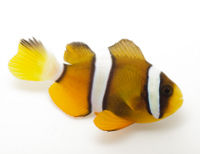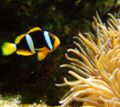Clark's Anemonefish (Amphiprion clarkii)
From The Aquarium Wiki
Clark's Anemonefish
Amphiprion clarkii
114 Litres (30 US G.)
14-15 cm (5.5-5.9")
8.1 - 8.5
22.2-25.6°C (72 -78 °F)
8-12 °d
?:1 M:F
2-5 years
Family
Pomacentridae
This animal is available captive bred
Contents
Additional names
- Clarkii Clownfish, Clark's Clownfish, Clark's Anemonefish, Yellowtail Anemonefish, Yellowtail Clownfish, Chocolate Clownfish
Additional scientific names
- Amphiprion clarki, Amphiprion boholensis, Amphiprion japonicus, Amphiprion melanostolus, Amphiprion papuensis, Amphiprion snyderi, Amphiprion xanthurus
Sexing[edit]
- The female is usually larger than the male.
Tank compatibility[edit]
- Do not keep more than one pair of Clownfish in a single tank as they're territorial. Will co-habit with other marine fish that are not a threat or aggressive.
Diet[edit]
- Will take most kinds of marine food including live and flake.
Feeding regime[edit]
- Best fed small amounts several times a day. If kept in a fertile and healthy reef situation, they can be fed less as they will find food around the live rock.
Environment specifics[edit]
- Known to host the following anemones, although most Indo-Pacific anemones will do: Cryptodendrum adhaesivum, Entacmaea quadricolor, Heteractis aurora, Heteractis crispa, Heteractis magnifica, Heteractis malu, Macrodactyla doreensis, Stichodactyla gigantea, Stichodactyla haddoni and Stichodactyla mertensii. These clownfish are known to be the least discriminate towards host choices, even accepting Hammer Coral as a host. This means that this fish will take up non-sympatric anemones, or anemones they are not associated with in the wild, such as the Curlique Anemone.
Behaviour[edit]
- The Clarkii can be quite territorial and will defend its host quite ferociously. It is even known to attack divers in the wild!
Identification[edit]
- Typical oval Clownfish shape. Two vertical white bands, one behind the eye and one above the anus. The caudal fin is white, sometimes tinged with yellow, but is always lighter than the rest of the body. Body colour varies on the locality of the fish. They usually have an orange base colour with varying degrees of black, sometimes just towards the back of the fish and sometimes covering the whole orange part of the body.
Pictures[edit]
External links[edit]
- Fishbase (Mirrors:
 )
)



